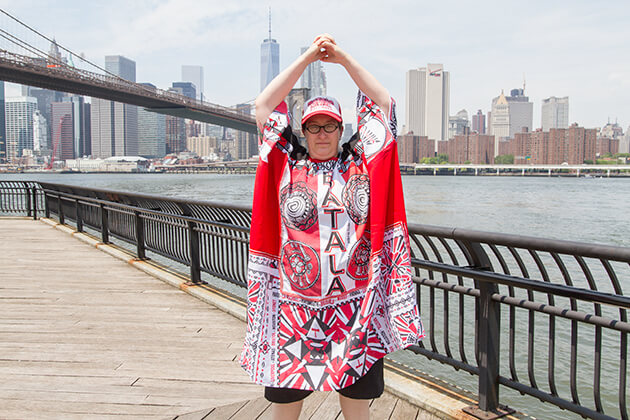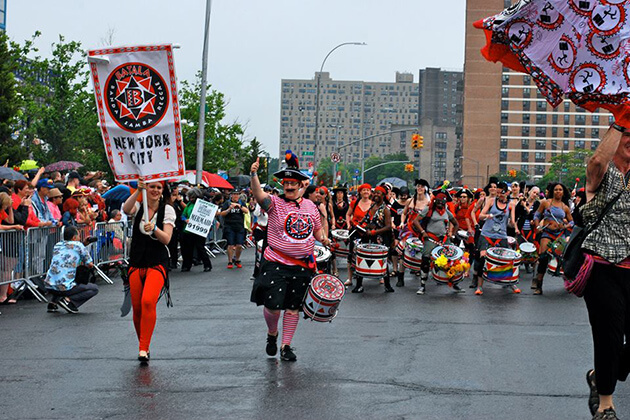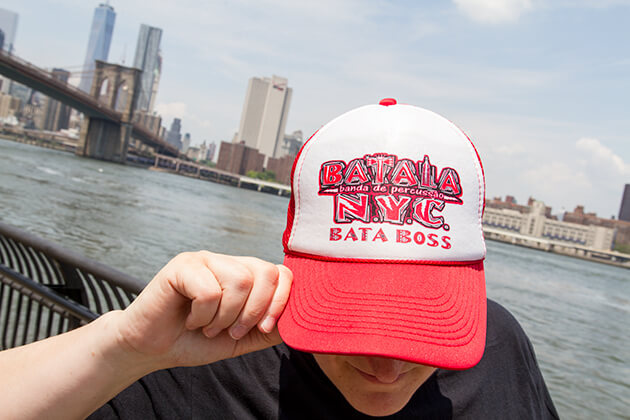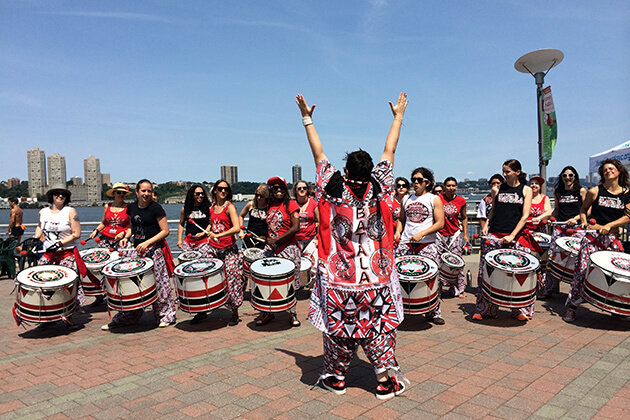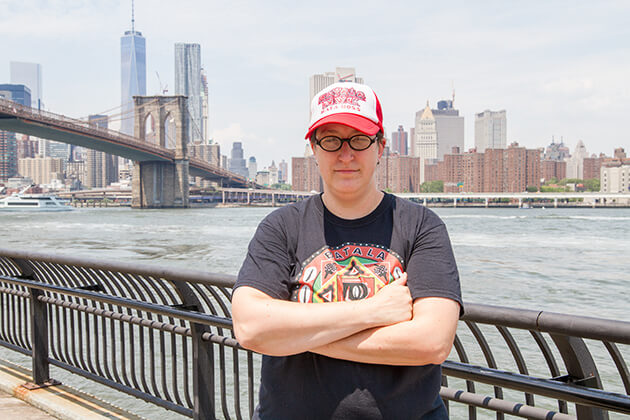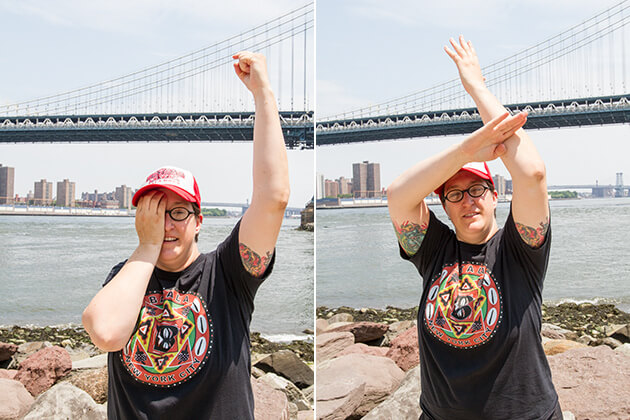Meet Batala NYC, the All-Female Brazilian Drum Troupe That Might Play Gloria Steinem’s Funeral
When Batala NYC first starts playing—seventy women moving as one group, following the hand signals of one conductor, and beating five different types of (mostly big) drums—people need a moment to collect their jaws from the floor. What is going on? Who are these women? Who is their caped conductor? In addition to the booming drumbeats, there’s also a sense of power and energy in the air—mixed in with some lighthearted fun. The women are smiling wide, thrusting their hands and drumsticks up fast and then back down in unison to strike notes, all the while bouncing to the rhythm from side to side on their feet .
At the Gowanus Ballroom six weeks ago, the women breezed through five minutes of playing while the audience cheered. Then, the women hit the ten-minute mark, the fifteen, the twenty-five (and showed no signs of slowing down), and finally the thirty, still non-stop drumming and smiling to the very end. By then, however, they were also dripping in sweat, partly because being in a samba reggae band is a workout and partly because the “ballroom” is actually a hot, large warehouse that was packed with people, food vendors, lumber, tools, and a pair of giant stage props.
What makes these women so indefatigable? So awe-inspiring? We recently caught up with Batala NYC’s artistic director, Stacy Kovacs, to find out how everything has come together for a band of volunteers that already opened for The Rolling Stones, graced a magazine cover, and played during this year’s parade for the Women’s World Cup champs—but only just celebrated its third birthday in March.
If you didn’t grow up playing in a Batala band, that’s because it’s a relatively new music project, now based out of Salvador de Bahia in northeastern Brazil, but first started in 1997 by Salvador native-son Giba Gonçalves while he was studying composition and bass guitar in Paris at the Conservatory. From France, the idea spread to England, Brazil, Spain, and then to the United States—to Washington, DC in 2007, before expanding to sixteen other countries around the world (the “Batala Mundo”) and counting.
Kovacs was playing with the Manhattan Samba group during the Brazilian Day Parade in 2011 when she first spotted the Washington, DC Batala band. “I saw this group warming up, dressed all in white and it was all women, and I was like, ‘That’s not New York, you know?'” she tells me. Kovacs watched, listened, and talked to some of their members before tagging along. Gonçalves was also there that afternoon, “up front in this elaborate outfit with this cigar” but Kovacs didn’t approach him. She thought about it for a few days, and then reached out to the Washington, DC group via e-mail. “I don’t know what possessed me,” she says.
The Washington group put her in touch with Paolo, Gonçalves’ assistant in Brazil, and before Kovacs knew it, she was convincing a percussionist friend, Laura Torell (now Batala NYC’s assistant director), to fly with her to Salvador de Bahia, play in one of the largest Carnivals in the world, and then help her bring back thirty-odd disassembled drums.
Save for the snare drum, which is American-made, the other three types of drums—the Surdo, the Dobra, and the Repique—are “made mysteriously” (Kovacs says) in a factory in Salvador de Bahia and spray painted by hand with the Batala name and logo. The band’s costumes and t-shirts are also made in Salvador, by members of Batala’s sister organization, the Cortejo Afro.
Kovacs and I are sitting at a picnic table in front of the carousel in Brooklyn Bridge Park, the site of Batala NYC’s first practice grounds once Kovacs and Torell had brought back the drums from Brazil and gotten together fifteen women to join their group. This is also the first place that kicked the band out for being too loud. “We have a seven block radius,” Kovacs says, laughing. “Manhattan blocks.”
She’s wearing a Batala t-shirt and has brought along her conductor’s cape for the photographs. For two years, Kovacs had been trying to get an official cape from the organization, but “kept getting the run-around,” she says, because it seemed to be a ‘men-only’ item (there are four all-female Batala groups worldwide, the rest are co-ed). Eventually, a former band member, who was also a costumer at the Metropolitan Opera, decided to put the issue to rest and made Kovacs a cape out of old Batala costumes. Now, she proudly wears it to every performance.
For many women growing up, percussion instruments were also implicitly only for men. “So many women wanted to do it and play drums, but when they were kids they were told, ‘Oh, you’re a girl, so here have a flute or a violin,'” says Kovacs, “or, ‘Drums are too loud for girls.’ You hear that a lot.” So, Batala NYC is shaking things up. “We’re playing this music that is very traditional Brazilian, traditionally male as well, with these big instruments that you don’t expect women to be carrying,” says Kovacs. “On top of that, we’re adding choreography, so we’re drumming and dancing. It’s a political statement in that sense.”
Kovacs started taking percussion lessons at eight years old, dabbled in piano, and eventually picked up the trombone, which took her to the jazz ensemble with Dick Clark’s American bandstand show for high school students; the 1993 opening ceremonies of the World University Games; and then the Michigan State University marching band. After college, Kovacs pursued a master’s degree in Boston while her instruments (sort of) gathered dust. It wasn’t until she moved to New York in 2005 that Kovacs started playing trombone and percussion again. And then, fortuitously, she met the Washington, DC Batala group and Gonçalves (whom she calls “the maestro”), and her life took a whole new direction.
As the leader of the New York group, Kovacs is responsible for running the weekly practices (Sundays, from 1 to 5pm) and booking the public and private shows for the band, among other things. Batala NYC has marched during the Mermaid Parade and New York’s Village Halloween Parade, but also has played weddings, bar mitzvahs, and fundraisers—”no funerals yet,” jokes Kovacs, but then adds seriously that Gloria Steinem recently said she wanted Batala NYC to play her funeral. Altogether last year, the band had around 140 performances.
“In New York, I’d say the longest we’ve played is five hours straight through in a parade,” Kovacs tells me. On average, however, Batala NYC’s performances last between thirty and forty-five minutes. “The shortest we’ve done is five minutes,” she says. The women wear knee pads under their costumes to prevent bruising from the instruments, and occasionally someone will crack a cuticle, which they jokingly call “sacrificing to the drum,” Kovacs says.
During the quick performances, which are known as “power sets,” Kovacs tries to “fit in as much as I possibly can of our repertoire in a very short amount of time, so it’s a lot of quick changes verses a longer set where we sit on one pattern for awhile and make up choreography as we go.” Although each band in the Batala Mundo plays Samba-reggae rhythms and songs written by Gonçalves, “where there’s blank spots in the Batala music, where there’s no official Batala choreography, we can add what we want—that’s the fun,” says Kovacs. A few weeks ago, they added The Bernie.
“Do you know The Bernie?” she asks me. “Where he’s dead and he’s dancing? Well, anyway, you look like you’re dead and you’re dancing in one section. We add fun stuff. We were doing the Cabbage Patch for awhile.” And, sometimes, Kovacs will also “just make up rhythms and will take one drum section out and then put them back in playing something I just made up in my head,” she says. “We do a lot of improvising when we’re in longer sets.”
Kovacs has a loose attendance policy, both for practices and for events. If you can make it, you show up and if you can’t, that’s okay, too. “Because we’re made of volunteers, and not everyone likes to parade, people will be like, ‘No, I’ll pass’ and I can’t force them to do it,” Kovacs says. But, if you’re serious about Batala, practices are essential, she explains. “It takes a lot of passion for it, and a lot of understanding that your roll is not an individual one but that you’re part of a section. It’s like a team. It also takes willingness to practice and get it down.”
The band sees a lot of turnover from women who join and then drop out for whatever reason—from family or job commitments to just being over-scheduled—so while they’ve “had over 230 or so women come through, we remain around size seventy,” with a “core group of twenty people who have been in it pretty much since the beginning,” says Kovacs.
She adds, “You can do it as a beginner, but you have to have patience first. Some people have natural ability, like they come in, they’ve never done it, and all of a sudden they’re amazing. You never know your talent until you try, so I let people try whatever drum they really want.”
At the Gowanus Ballroom, I notice that the age range of the band easily spans five decades, and Kovacs clarifies that the oldest drummer is seventy-one and the youngest is thirteen. “You have this seventy member group of women coming down the street—this white, red, and black machine,” she says, “and then you’re like, ‘Wow, that’s all women? Really?’ That’s badass.”
On August 15, Batala NYC will be playing a public show at the North Crown Heights Festival of the Arts in Brower Park, Brooklyn.
You might also like 









